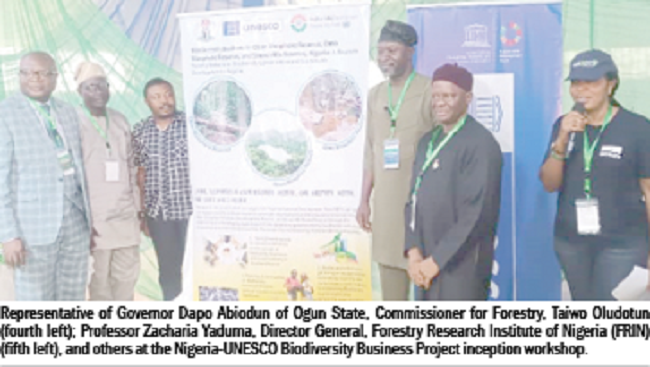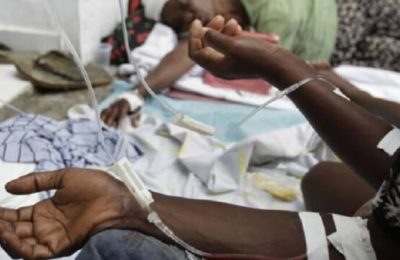Many rural communities in Nigeria rely heavily on their natural environment for their livelihoods and socioeconomic well-being. Local populations in and surrounding forest ecosystems depend greatly on biodiversity and natural resources for their survival. Biodiversity is therefore an important life support system.
However, their reliance on biodiversity is frequently unsustainable, as evidenced by river chemical fishing, hunting, and the destruction of forest areas for subsistence farming, among other things. These behaviours put undue strain on the ecosystem, resulting in loss of biodiversity and natural resources. Decline of biodiversity is a threat to both nature and people.
In attempt to counteract this negative spiral, the Nigerian government collaborated with UNESCO to develop the project titled “Biodiversity Business in Oban Biosphere Reserve, Omo Biosphere Reserve, and Shere Hills Forest Reserve, Nigeria: A Means to Poverty Reduction, Biodiversity Conservation and Sustainable Development in Nigeria,” otherwise called “Nigeria-UNESCO Biodiversity Business Project.”

The goal of the project is to improve livelihood of local communities, contribute to wealth/job creation and support biodiversity conservation in Oban Biosphere Reserve, Omo Biosphere Reserve and Shere Hills Forest Reserve, through the establishment of green biodiversity businesses and green economy activities, with a focus on youth and women entrepreneurship.
The Nigeria-UNESCO Biodiversity Business Project is being funded by the India-UN Development Partnership Fund, Commonwealth Window. The project is implemented by UNESCO in collaboration with the Federal Ministry of Environment, the Nigerian Man and Biosphere (MAB) Committee, Forestry Research Institute of Nigeria (FRIN), the National Park Service (NPS), and relevant agencies, to implement this laudable project three sites – Oban Biosphere Reserve, Omo Biosphere Reserve, and Shere Hills Forest Reserve.
The project and its steering committee were inaugurated in December 2023 by the Minister of Environment, Mallam Balarabe Abbas Lawal. Project site inception workshops for the three project sites were scheduled to take place at Oban Biosphere Reserve; Omo Biosphere Reserve and Shere Hills Forest Reserve.
On June 25, the project site inception workshop for Omo Biosphere Reserve took place.

Omo Biosphere Reserve
If you plan to do a live video within Omo Forest Reserve to showcase the beauty of a nature in a pristine forest, you would probably need a satellite link for internet. As you travel the road from J4 junction on Benin-Sagamu Expressway that leads to Omo Biosphere Reserve, you will not have gone too far before you lose cell signals. Indeed, the journey into Omo forest reserve will cut you off from the outside world and connect you with the beauties and wonders of plant and animal diversity that has now become a precious commodity in a world bent on turning forests into concrete jungles. Omo Biosphere Reserve is located in Ogun State. Its size covers two local governments: Ijebu North and Ijebu East.
As a forest reserve, it is protected by rangers from the National Parks Service. There is also a zone within Omo Biosphere Reserve known as a Strict Natural Reserve (SNR). These 460 hectares of forest are managed by FRIN.
Omo forest was designated as a biosphere reserve in 1977, making it the first of such in the country.
A number of forest reserves would later become biosphere reserves. They are Oban Biosphere Reserve and Okwangwo Biosphere Reserve both in Cross River State; and Hadejia-Nguru-Bade Biosphere Reserve that occupies Jigawa and Yobe states. Two more biosphere reserves are to be established in Shere Hills Forest Reserve in Plateau State, and Yankari Game Reserve in Bauchi State.
Kickstarting the project
For Omo Biosphere Reserve, the project site inception workshop took place as scheduled on Tuesday, June 26, at Ogun State Plantation Hall, Area J4 in Ogun State.
Aside from kickstarting the project at the site, the inception workshop was done to present details of the project to stakeholders and the benefitting communities. Consultations were held with the benefitting communities to have their thoughts on the project, as well as to establish a working relationship with them. Lastly, the workshop provided an avenue to receive from the benefitting communities possible choices of biodiversity businesses or “green income” generating livelihoods that will be justified through proper market survey, socio-economic survey/product analysis and biodiversity inventory.
Benefitting communities at Omo Biosphere Reserve are: Aba Kurudu, Osoko Laoka, Etemi, Akpora, Sojukorodo, Abeku 1, Abeku Adekanbi, Owode, Mokore, Eseke and Tami Tami.
Governor Dapo Abiodun of Ogun State, represented at the event by his Commissioner for Forestry, Taiwo Oludotun, expressed the support of the state government towards the project. He appreciated the National Commission for UNESCO and the Man and Biosphere team for “their consistent support for Omo Biosphere Reserve through series of interventions over the years.”
He said, “Biodiversity is the fabric of our planet. Omo Forest Reserve gained the status of a UNESCO biosphere reserve in 1977 due to the rich biodiversity composition of the area. The status has been sustained through the positive effort of different stakeholders to conserve the species and ecosystem of this important biodiversity hotspot.” He noted the fact that communities depend on forest for their livelihood, and “forests are home to nine out of 10 people living in extreme poverty. This suggests that implementing policies that will promote conservation of biodiversity will directly improve livelihood and reduce extreme poverty.”
The governor commended the organiser of the project, adding that his government has approved 4,000 hectares of forest land to be gazetted as a protected forest.
Professor Zacharia Yaduma, Director-General of FRIN and focal point for Man and Biosphere Programme, at the event appreciated the contributions of the Ogun State government towards the successful implementation of past projects at Omo Biosphere Reserve.
He noted that “Biodiversity, the basis of life that encompasses all living organisms, is not only essential for the health and resilience of our planet but also for the well-being of humanity. As we gather here today, we acknowledge the critical importance of conserving biodiversity and recognise the pressing need to address the intertwined challenges of poverty and environmental degradation.
“Our biosphere reserves stand as beacons of hope in our collective quest for sustainable development. They represent areas where conservation, sustainable development, and human well-being intersect. Through innovative approaches and inclusive partnerships, biosphere reserves offer a unique opportunity to harness the potential of biodiversity-based businesses as a catalyst for poverty reduction and biodiversity.”
In his address at the workshop, Mr Abdourahamane Diallo, the Head of UNESCO Abuja Office and UNESCO Representative to Nigeria, said: “The goal of the project which aligns with Nigeria’s National Development Plan (NDP) (2021-2025) will help to improve local communities’ socio-economic status through biodiversity businesses while conserving biodiversity and supporting also, women and youth entrepreneurship.”
He added that “Today’s inception workshop will therefore provide a platform for consultations with the selected communities of Omo biosphere Reserve and receiving their thoughts and inputs on the biodiversity businesses that could be established for their good, and within the framework of the project.
“I therefore congratulate you the benefiting communities and implore you to support the implementation of the project for the good of your men, women and young people.”
Diallo, who was represented by Dr Enang Moma, National Professional Officer at UNESCO Abuja office, noted that “Biodiversity supports life, and we depend on it for our daily consumption; as such we must treasure it and sustain these important resources for the future generations.”
Mr Lateef Olagunju, the Secretary General of the National Commission for UNESCO in Nigeria, said the project “is an opportunity to empower our local communities to thrive in harmony with nature and harness the potentials of biosphere diversity as a catalyst for positive change by fostering entrepreneurship, innovation and community development in and around the reserve.” He called for continued collaboration to unlock new opportunities for sustainable livelihood while safeguarding biodiversity for future generations.
Speaking on behalf of the community, Olukayode Shonibare, the acting project manager, said: “UNESCO has been a good partner with the government in bettering the living condition of our people living in this enclave. I want to assure the team that we will monitor the activities so that we can achieve the desired goal.”
Significance of Omo
Dr Tayo Oyelowo of Forest Conservation and Protection Department, FRIN and Omo Biosphere Reserve Project Focal Point, spoke on the importance of the reserve. According to him, Omo Biosphere Reserve provides support for demonstration projects, environmental education and training and research conservation. It also fosters economic and human development which is socio-culturally and ecologically sustainable. The reserve has a terrestrial core area of 8 square kilometres (460 ha); a buffer zone of 142 square kilometres and a transition area of 1156.5 square kilometres. No destructive sampling is allowed within the core area, neither is harvesting of plants or hunting allowed. The buffer zone shields and protects the core area from any accidental activities. Enrichment activities are allowed in the zone. Farming, plantation exploitation, timber exploitation, firewood harvesting, timber industries and housing development can take place in the transition area.
He said, “42 mammals, 15 reptiles and three other species can be found in the reserve. They include elephants and the white-nosed monkey. There are 110 avian species belonging to 38 families. The biodiversity shows that Omo Biosphere Reserve supports a large number of insects and animal species.”
When it comes to plants, “Omo Biosphere Reserve is also one of the numerous sites across Nigeria designated as Important Bird Areas (IBA) because of its high bird species richness. With documented reports of about 203 bird species 52 of which some species are migratory while others are residents; about 166 bird species have been recorded presently,” Dr Oyelowo added.
Read Also: Tinubu approves national construction, household support programme rollout







